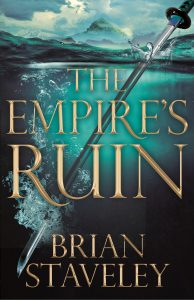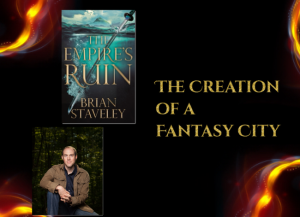Creepy Old Shit – The Creation of a Fantasy City: Guest Post by Brian Staveley
“I hate useless, creepy old shit.”
So says a friend of mine on the subject of ancient relics in fantasy novels. Coming in for particular censure are mysterious old buildings, old roads, old statues, and “that stupid Logoth place where everything is a scary little alleyway.”
For my part, I found the stupid Logoth place (Shadar Logoth of Robert Jordan’s first book) both interesting and terrifying, so this remark set me pondering about the creation of fantasy cities.
Partway through The Empire’s Ruin, for instance, a group of sailors and soldiers discovers an abandoned city on the far side of the globe, a totally vacant metropolis with a huge ziggurat at the center. Yes, yes, fine, good—mystery, megastructure, sense of impending dread. Check, check, check.
Onward, I said to myself, hurling my characters deeper into the winding streets…
Except—hold on. Are the streets winding?
This looks like an easy, innocuous question. It is not.
 Winding streets are not just winding streets. They are statements about history and politics. A city of winding streets, like Boston, Massachusetts, is almost always one in which growth has taken place organically, haphazardly, over decades or even centuries—cow paths becoming cobbled lanes becoming major thoroughfares. A grid, on the other hand, indicates serious planning, which in turn suggests a centralized power with the political vision, will, and resources to raze and rebuild old neighborhoods. Think of Manhattan. Or Haussmann’s renovation of Paris.
Winding streets are not just winding streets. They are statements about history and politics. A city of winding streets, like Boston, Massachusetts, is almost always one in which growth has taken place organically, haphazardly, over decades or even centuries—cow paths becoming cobbled lanes becoming major thoroughfares. A grid, on the other hand, indicates serious planning, which in turn suggests a centralized power with the political vision, will, and resources to raze and rebuild old neighborhoods. Think of Manhattan. Or Haussmann’s renovation of Paris.
Of course, it’s not just a matter of building a plausible city. I’m writing fantasy here, and so of course there are massive pits dug into the bedrock, pits with scratches gouged into the walls as though something horrible and desperate spent long years trying to escape. But now, come on. Who was responsible for feeding these things? Prisoners? Some kind of priestly caste? How does the priestly caste work? How are those people selected? Heredity? If so, how are these lineages related to the other political powers in the city? If there are competing nexuses of power, these will almost certainly be reflected, even if only subtly, in the architecture. Witness, for instance, the towers of San Gimignano.
In the end, the only solution is to start at the start, writing out the history of the city from its founding (the shipwreck of an exploratory fleet), to its early consolidation and development, to its usurpation by an immortal god-king. And the great thing is that, after having completed this document, the description of the city begins to write itself. Of course the statues should be grotesque and monstrous, not just because grotesque and monstrous statues are more interesting, but because they spring directly from the religious beliefs of the people, which in turn spring from the world in which they live. Of course the ravines that divide the city are spanned by removable bridges, because this is a city that was, in many ways, at war with itself. With the history, politics, and economic situation worked out, even tiny details fall into place.
And once I’ve taken the time (usually a full working day) to write out everything about a city, these details feed back into the plot. Understanding the political organization is crucial when it comes time to describe how these people make war. A clear-eyed view of the religion provides dozens of tiny details—curses, rituals, armor, burial practices, superstitions—that I’m deploying now in the second book in the series.
It always feels like a detour to stop writing the book in order to come up with the history of a city that never existed, but if there’s one thing we can learn from fantasy it is to distrust the straight way and embrace the twisting, winding, secret paths of the world.
I live on a long dirt road in rural Vermont where I divide my time between mountain biking with my son, trying to play piano music that is far too difficult for me, running trails, doing laundry, splitting wood, thinking I really ought to wash the kitchen floor and then not, cursing at the pie crust for sticking to the surface, drinking beers with friends out by the firepit, and sometimes trying to write books.


Insightful! Everything can be a telling detail if one pays attention.
On a related note, can people please stop running through jungles? Jungles are actually really jungly, particularly long-forgotten eldritch ones where the brave dare not go. Pathless, is what I’m getting at, unless of course there are large monstery beasts dragging their bloated bodies through the underbrush, in which case sure, run all you like; just don’t blame me when you get eaten.